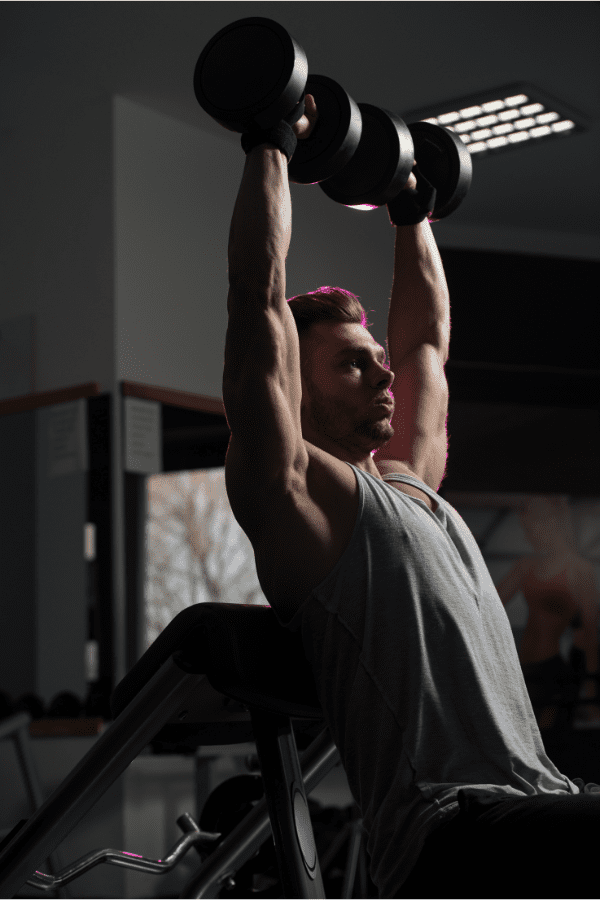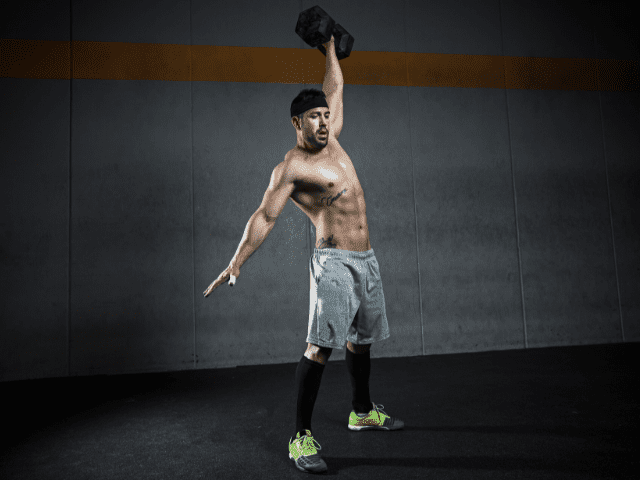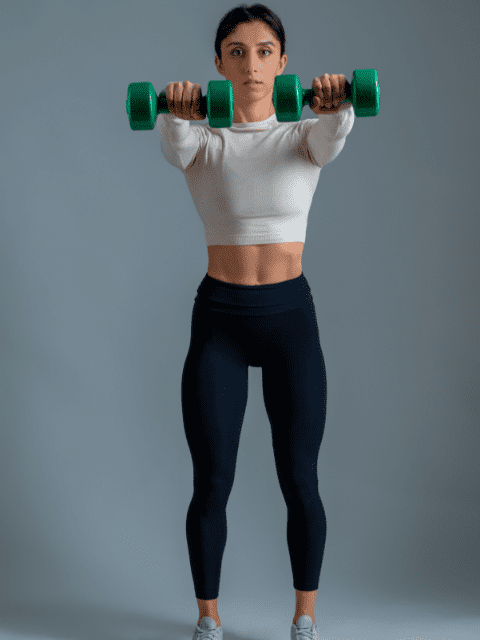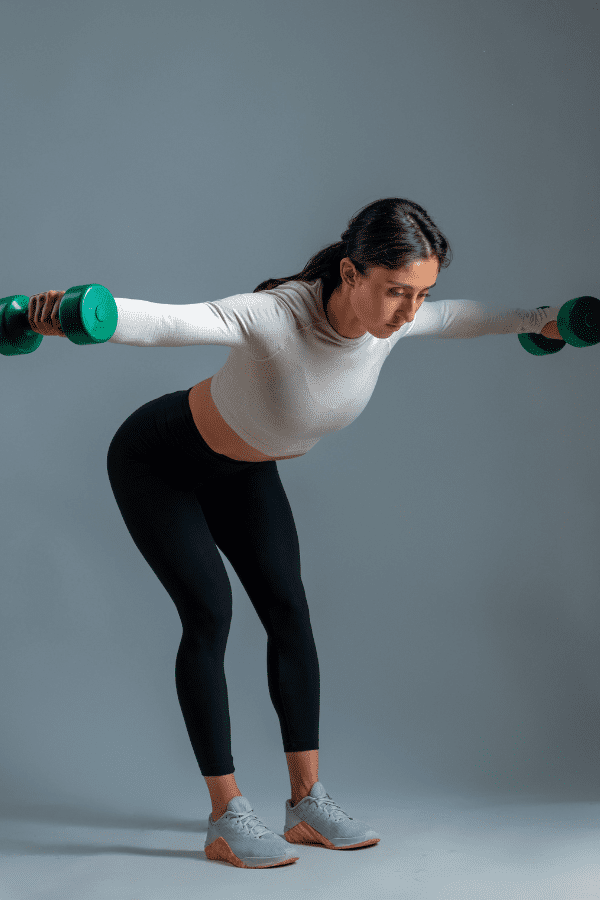11 Best Dumbbell Exercises For Shoulders (Strength & Size)
Honestly, who doesn’t love shoulder workouts? Whether you’re an athlete developing upper body strength or just someone wanting to look good in a tank top, strong shoulders play a critical role.
And what better way to get those shoulders in shape than with a pair of trusty dumbbells? Not only are dumbbells a versatile piece of equipment, but they also provide a unique challenge to your stabilizer muscles, making them a great tool for building functional strength.
But with so many exercises to choose from, it can be overwhelming to know where to start.
Fear not, fellow weight room warriors, because I’ve got you covered. In this article, I’ll be diving into the best dumbbell exercises for shoulders, from tried-and-true classics to some lesser-known gems that will have you feeling the burn in all the right places.
Dumbbell Exercises for Shoulders
Dumbbell Shoulder Press

It’s hard to not start with Dumbbell Shoulder Presses. If we’re talking about developing strong shoulders, the classic Dumbbell Shoulder Press is still the most effective dumbbell exercise to use.
That doesn’t mean your Dumbbell Shoulder Presses need to be boring though. There are so many Shoulder Press variations you can utilize with dumbbells.
Standing, Seated, Single Arm and Alternating are just some of the ways you can mix up your Dumbbell Shoulder Press routine.
There are even a couple more unique variations that I’ll get to later on this list.
Step-by-Step Instruction
- Stand with the dumbbells next to you.
- Hinge and the waist and bend the knees until you can grab the dumbbells.
- Keep a neutral spine, and a nice flat back, and lift the dumbbells into your pressing position.
- I recommend palms face away or toward each other (whichever feels more comfortable).
- Brace the abdominal muscles and engage the upper back.
- Press the dumbbells directly overhead. The dumbbells should not track forward.
- Lock the reps out and pause for about 1 second with each repetition.
- Slowly lower the dumbbells back to the starting position to prepare for the next repetition.
Coaching Points
Keep the core engaged as you press. If you feel you are arching your back as you reach closer to lockout, consider going down in weight.
Remember this is not a push press. This is a purely upper-body pressing movement. If you are using your legs, even slightly, this would be called a Push Press. The push press is a great movement as well BUT a shoulder press should be focused on the shoulders, no cheating.
Dumbbell Single-Arm Snatch

Yes, it’s possible to work explosive movements and shoulders at the same time.
And, yes, it’s possible to do this with dumbbells.
In fact, one dumbbell is all you need to do Dumbbell Single-Arm Snatches.
They’re one of the most beginner-friendly Olympic lift variations and a great way to work hip power and shoulder strength and stability all in one movement.
Step-by-Step Instructions
- Grab a dumbbell and stand with feet about shoulder-width apart.
- Put a slight bend in the knee, brace the core and set the back – shoulder blades pulled back, lats engaged, chest out.
- Hinge forward by pushing the hips back and let the dumbbell slide down right in between the knees, coming at a stop just below the knee.
- You are now in the ‘power position’.
- From here, drive the feet through the floor and aggressively extend the hips, driving the shoulders up and slightly back.
- As you reach triple extension of the hips, knees and ankles – use a quick, powerful shrug and allow the elbow to break and begin the pull with the arm.
- Keep the dumbbell close to the body as it travels up.
- Once the dumbbell reaches the highest point of the pull, rotate at the elbow to catch the dumbbell overhead while simultaneously dropping the hips into a quarter squat and shift the feet slightly out.
- Finish the rep by standing tall and lowering the dumbbell down to the shoulder first and then back to the starting position under control.
- Repeat until all reps are completed and then switch arms.
Coaching Points
The two biggest mistakes that I see with Single Arm Snatches are not keeping the dumbbell close to the body on the way up and letting the dumbbell ‘yank’ the shoulder down as it comes back to the starting point.
The dumbbell should travel close to the body all the up until it gets about head height, then rotate the elbow, drop the hips and catch. Don’t allow it to swing forward out away from the body.
The second technique flaw is not staying braced through the return of the dumbbell to the starting position, oftentimes from being in too big of a hurry to knock out reps. Letting the dumbbell, especially the heavier you get, yank the shoulder down at the bottom of the rep is asking for trouble.
Arnold Press
Arnold Press is one of the Dumbbell Shoulder Press variations I was just referencing above.
Named after the legend, Arnold Schwarzenegger, Arnold Presses incorporate a bit more horizontal range of motion in addition to the vertical press. This gets the anterior and posterior delts even more involved in the movement.
Step-by-Step Instruction
- Stand* with the dumbbells next to you.
- Hinge and the waist and bend the knees until you can grab the dumbbells.
- Keep a neutral spine, and a nice flat back, and lift the dumbbells into your pressing position.
- You will start with the palms facing you.
- As you press the dumbbells up, rotate the dumbbells as you press, and at the top of the movement, your palms will be facing away.
- As you lower the dumbbells back to the start, rotate the dumbbells until your palms are facing you.
Coaching Points
*Can also be done seated as in the video above.
This is an exercise that is programmed for hypertrophy. Control the weight and focus on time under tension. This one is going to burn, so grit your teeth, and enjoy it!
Keep the core engaged as you press. If you feel you are arching your back as you reach closer to lockout, consider going down in weight.
Dumbbell Side Raise
Dumbbell Side Raises (also often referred to as Lateral Raises) are one of the my all-time favorite shoulder exercises.
The isolation on the medial delt is excellent. The pump is tremendous. It’s one of the those exercises that you can feel right where it’s working right as you’re doing them.
They’re not the same strength-building type of exercise as the vertical presses on this list, but as a shoulder-finisher at the end of a workout it’s hard to find many exercises better.
Instructions
- Hold dumbbells-palm in, arms straight down at sides.
- Raise dumbbells in semicircular motion slightly above shoulder height tilting the head of the dumbbell down.
- A slight pause, then lower to starting position under control.
- Keep your arms straight with just a slight bend in the elbow.
- Use the same path to continue repeated reps.
- Exhale up, inhale down.
Coaching Points
To keep the focus on the medial delt, make sure to keep your palms down at the top of the movement. Many lifters like to pull back, instead of lift straight out to the sides, which brings the stronger muscles of the upper back into play.
Also, always start the movement at the side of the thigh. Bringing the dumbbells in front of the body allows for more of a momentum swing and takes away from the stress placed on the delts.
Dumbbell Front Raise

The Dumbbell Front Raise is the anterior delt equivalent of the Dumbbell Side Raise for medial delts.
Most Anterior Delt movements are presses that involve multiple muscle groups in addition to the shoulders.
However, Front Raises can really isolate the anterior delts like few other exercises can.
Instructions
- Hold dumbbells in front of thighs, palms facing in.
- Arms should be straight, elbows very slightly bent.
- Raise dumbbells straight up in front of the body, keeping arms straight, until they reach about eye level.
- Return to the starting position using the same movement path.
- Repeat for the designated number of reps.
Coaching Points
Elbows should not be completely locked out as this puts an unnecessary strain on the joint. Instead, keep a slight bend in the elbow throughout the movement.
Return the dumbbells to the front of the thighs for each rep. Letting them swing down beside the body will create momentum and reduce the emphasis on the shoulders.
Speaking of momentum, do not rock. If you find yourself rocking back and forth to help you lift the weight – the weight is too heavy. Grab lighter dumbbells and keep your torso still during the lift.
Dumbbell Rear Delt Raise

The third movement in the Big 30 trifecta (more on the Big 30 coming up next) is the Dumbbell Rear Delt Raise.
If done correctly, the Dumbbell Rear Delt Raise will do an excellent job at targeting and strengthening the rear delt muscle – an often overlooked, but extremely important muscle to keep your shoulders healthy.
Don’t get too heavy (which can cause the bigger, stronger muscles of the back to take over) and really focus on working the rear delts.
Step-by-Step Instruction
- Grab your dumbbells (or plates) and bend at the waist until you are close to perpendicular to the floor.
- I recommend slightly bending the elbow and keeping your palms facing each other. As you execute the movement, the palms will face the floor.
- Initiate the movement by bringing your arms out to the side and squeezing the shoulder blades.
- Pause at the top of the movement for about 1 second.
- Slowly lower your arms back to the starting position.
Coaching Points
In the setup, be sure to bend at the waist enough so that you are perpendicular as much as possible. In this movement, the burn should be felt in the upper back and rear shoulders. If your setup is too vertical, you may feel the burn in the traps or medial delts.
Don’t hitch (bounce) into lockout. If you find yourself using your torso to hitch, go down in weight. The emphasis here is on time under tension and quality movement still matters.
Do not bang the dumbbells together at the bottom of the rep. Stay in control of the movement throughout.
Big 30
The Big 30 is a giant set of the three previous dumbbell shoulder exercises – the Side Raise, Front Raise and Rear Delt Raise.
A giant set involves doing multiple movements, back-to-back, with no rest in between. It’s a great way to add some variety to workouts and absolutely torch your shoulders.
Step-By-Step Instructions
- Start in a standing position, feet shoulder-width apart, dumbbells in hand.
- Begin by doing 10 Dumbbell Front Raises.
- Once those reps are completed immediately transition into 10 Dumbbell Lateral Raises.
- Once those reps are completed immediately transition into 10 Rear Delt Raises.
Coaching Points
The key to the exercise is to do each exercise back-to-back-to-back with no rest in between and without sitting the dumbbells down until all reps are completed.
Because all three exercises are done in a row you’ll need to use a lighter weight than you would doing each individually.
Dumbbell Z Press
The Dumbbell Z Press is a unique Dumbbell Shoulder Press variation that involves sitting directly on the ground instead of standing or seated on a bench.
This starting position places a ton of emphasis on the core to maintain a vertical torso without falling backward.
If you want to get your core more involved in your workout or just want to add some variety to your shoulder pressing, the Dumbbell Z Press is a great option.
How To
- Sit on the floor with legs straight out in front.
- Brace the core and raise dumbbells to shoulder level (or have a partner hand them to you).
- Make sure your posture is good and your core is tight before trying to press.
- Press the dumbbells to full extension overhead.
- Lower the dumbbells back down to the shoulders and repeat until all reps are completed.
Coaching Points
The Dumbbell Z Press demands hamstring flexibility and core stability to maintain the body position while pressing. Deficits in either of these areas will greatly hinder your ability to be able to do Z Presses.
Make sure to maintain a vertical torso throughout the movement so that you’re pressing the dumbbells directly over the ears.
Dumbbell Curl and Press
Dumbbell Curl and Press is the last shoulder-pressing variation on the list. This variation is a combo of bicep curls and shoulder presses.
As you should be able to tell by now, finding variety in your shoulder workouts shouldn’t be an issue if you have a pair of dumbbells to workout with.
Step-by-Step Instruction
- Grab dumbbells that you can perform at least 8 perfect reps with here.
- Standing nice and tall, hammer curl the dumbbells up to shoulder height.
- From here, press the dumbbells straight up overhead to lockout.
- Slowly bring the dumbbells back and down to shoulder height.
- From here, slowly return the dumbbells to your side.
Coaching Points
Go slow! Time under tension is key here. Feel the burn, especially on the way back down.
It’s easy to get out of control and begin swinging dumbbells all over the place with Curl and Presses. Stay in control of the weight throughout.
Dumbbell Upright Row

Dumbbell Upright Row is often thought of as a back exercise (they’re a great dumbbell exercise for traps), but they also do a great job of working the shoulders.
All three heads of the shoulder come into play along with the upper traps and biceps.
The fact that Upright Rows hit so many muscle groups makes it an excellent supplemental exercise for almost any upper-body workout.
Step-by-Step Instructions
- Grab two dumbbells and start with them at arm’s length in front of the thighs, palms toward the body.
- Flex knees slightly and stand upright with good posture.
- Pull the dumbbells upward along the abdomen and chest toward the chin.
- At the top, the elbow should be higher than the wrist, and above the shoulders.
- Lower the bar dumbbells and under control to the front of the thighs.
- Do not ‘jerk’ or ‘rock’ the weight up and keep the dumbbells close to the torso thoughout.
Coaching Points
The biggest mistake I see, by far, with Dumbbell Upright Rows is swinging way too much to lift the weight.
A little swing is okay if you’re trying to grind out the last rep or two of a set, however, if you’re having to rock your torso for every rep then the weight is too heavy. Grab some lighter dumbbells and use proper form.
Incline Dumbbell Front Raise
Incline Dumbbell Front Raises are a variation of the more popular Dumbbell Front Raises done from a standing position.
Using an incline bench takes the lower body out of the equation (no cheating) and gets the medial delt more involved in the movement.
Step-by-Step Instructions
- Set up an adjustable bench to roughly a 45-degree angle.
- Lay your chest down on the bench with your head just off the top edge of the bench.
- Inhale in, brace your core and raise your arms straight out in front up to shoulder height
- After a quick pause at the top, lower the dumbbells back to the starting position, exhaling out on the way down.
- Repeat for the designated number of reps.
Coaching Points
The angle of the bench will determine the amount of emphasis placed on the different muscles of the shoulder. The more upright the angle, the more emphasis that will be placed on the anterior part of the deltoid. The lower the angle, the more the medial (and possibly even the posterior) delt will come into play.
Easily the biggest mistake I see with Incline Dumbbell Front Raises is swinging the dumbbells at the bottom of the movement and using momentum to raise them back up. Stay in control of the weight throughout the movement.
If you feel you need to swing the dumbbells to lift them then the weight is too heavy. Lower the weight so you can use proper form.

Get Shredded… For Free
Get a free workout Monday through Friday, posted right here on Horton Barbell. These workouts are designed to help you get strong, in shape and look great at the beach!
Final Thoughts
Barbells, Medicine Balls and Resistance Bands are great, but all you really need to get in a great shoulder workout is a pair of dumbbells.
Whether you have a set of dumbbells or a pair of adjustable dumbbells, there is no shortage of great dumbbell exercises for shoulders to choose from.
I hope this list helped you put together a great workout, or maybe just fill a gap in a dumbbell workout you were already doing.
If you are using dumbbells for most of your workouts, then you should definitely check out my favorite dumbbell exercises for chest as well. Lots of good ideas and each exercise comes with a full description to you can implement them into your program right away.
